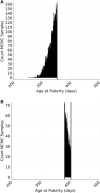Estimating Heritabilities and Breeding Values From Censored Phenotypes Using a Data Augmentation Approach
- PMID: 35957692
- PMCID: PMC9358037
- DOI: 10.3389/fgene.2022.867152
Estimating Heritabilities and Breeding Values From Censored Phenotypes Using a Data Augmentation Approach
Abstract
Time-dependent traits are often subject to censorship, where instead of precise phenotypes, only a lower and/or upper bound can be established for some of the individuals. Censorship reduces the precision of phenotypes but can represent compromise between measurement cost and animal ethics considerations. This compromise is particularly relevant for genetic evaluation because phenotyping initiatives often involve thousands of individuals. This research aimed to: 1) demonstrate a data augmentation approach for analysing censored phenotypes, and 2) quantify the implications of phenotype censorship on estimation of heritabilities and predictions of breeding values. First, we simulated uncensored phenotypes, representing fine-scale "age at puberty" for each individual in a population of some 5,000 animals across 50 herds. Analysis of these uncensored phenotypes provided a gold-standard control. We then produced seven "test" phenotypes by superimposing varying degrees of left, interval, and/or right censorship, as if herds were measured on only one, two or three occasions, with a binary measure categorized for animals at each visit (either pre or post pubertal). We demonstrated that our estimates of heritabilities and predictions of breeding values obtained using a data augmentation approach were remarkably robust to phenotype censorship. Our results have important practical implications for measuring time-dependent traits for genetic evaluation. More specifically, we suggest that data collection can be designed with relatively infrequent repeated measures, thereby reducing costs and increasing feasibility across large numbers of animals.
Keywords: MCMC; baysian; breeding; censored; data augmentation; gibbs sampling.
Copyright © 2022 Stephen, Cheng, Pryce, Burke, Steele, Phyn and Garrick.
Conflict of interest statement
Authors MS, CB, NS, and CP were employed by DairyNZ Limited. The remaining authors declare that the research was conducted in the absence of any commercial or financial relationships that could be construed as a potential conflict of interest.
Figures


Similar articles
-
Comparison of methods for deriving phenotypes from incomplete observation data with an application to age at puberty in dairy cattle.J Anim Sci Biotechnol. 2023 Sep 9;14(1):119. doi: 10.1186/s40104-023-00921-5. J Anim Sci Biotechnol. 2023. PMID: 37684681 Free PMC article.
-
Variance parameter estimation for age at puberty phenotypes under 2 levels of phenotype censorship.JDS Commun. 2022 Jun 17;3(5):339-342. doi: 10.3168/jdsc.2022-0218. eCollection 2022 Sep. JDS Commun. 2022. PMID: 36340907 Free PMC article.
-
Comparison of models for the genetic evaluation of reproductive traits with censored data in Nellore cattle.J Anim Sci. 2016 Jun;94(6):2297-306. doi: 10.2527/jas.2016-0273. J Anim Sci. 2016. PMID: 27285907
-
Review: Opportunities and challenges for small populations of dairy cattle in the era of genomics.Animal. 2016 Jun;10(6):1050-60. doi: 10.1017/S1751731116000410. Epub 2016 Mar 9. Animal. 2016. PMID: 26957010 Review.
-
Invited review: Phenotyping strategies and quantitative-genetic background of resistance, tolerance and resilience associated traits in dairy cattle.Animal. 2019 May;13(5):897-908. doi: 10.1017/S1751731118003208. Epub 2018 Dec 7. Animal. 2019. PMID: 30523776 Review.
Cited by
-
Comparison of methods for deriving phenotypes from incomplete observation data with an application to age at puberty in dairy cattle.J Anim Sci Biotechnol. 2023 Sep 9;14(1):119. doi: 10.1186/s40104-023-00921-5. J Anim Sci Biotechnol. 2023. PMID: 37684681 Free PMC article.
References
-
- Bezanson J., Edelman A., Karpinski S., Shah V. B. (2017). Julia: A Fresh Approach to Numerical Computing. SIAM Rev. 59, 65–98. 10.1137/141000671 - DOI
-
- Cheng H., Fernando R., Garrick D. (2018). JWAS: Julia Implementation of Whole-Genome Analysis Software. in Proceedings of the world congress on genetics applied to livestock production, Auckland, New Zealand, 859.
-
- Dennis N. A., Stachowicz K., Visser B., Hely F. S., Berg D. K., Friggens N. C., et al. (2018). Combining Genetic and Physiological Data to Identify Predictors of Lifetime Reproductive Success and the Effect of Selection on These Predictors on Underlying Fertility Traits. J. Dairy Sci. 101, 3176–3192. 10.3168/jds.2017-13355 - DOI - PubMed
LinkOut - more resources
Full Text Sources

